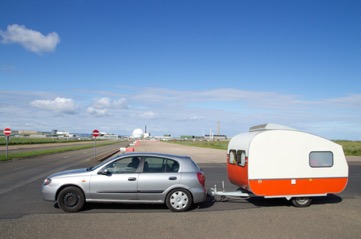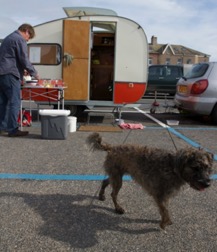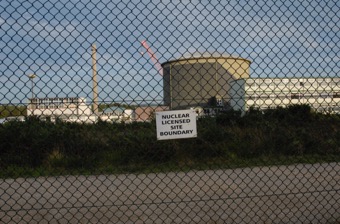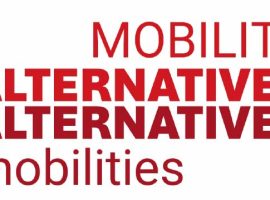The Nuclear Family Project: The Art of Touring the Toxic, Pt 1
By Dr. Sharon Wilson, Newcastle Business School, Northumbria University
This is the first part of a 2-part series Dr. Wilson is writing on tourism and activism related to nuclear sites. For more about Dr. Wilson and her work, visit her faculty page.
In the guise of a family holiday, artists Lindsay Duncanson, Marek Gabrysch and their 11 year old son Lukas toured the British Isles to explore 16 active and decommissioned nuclear power stations. By using the ‘Egg’ touring caravan as a living space and art studio, this creative family began a 2200 mile journey to visit nuclear industrial sites from Dounreay in Caithness to Dungeness in Kent. Using these ‘toxic’ sites for artistic exploration and recreation constitutes an unconventional form of tourism. Hannam and Yankovka1 note, ‘dark’ and ‘toxic’ tourism has developed as the numbers of travellers interested in death, sufferings and disasters have grown significantly of late. Whilst this project is not dark tourism per se, it does prompt a conversation about a human interest in the macabre or, in this case, how non-touristic sites may be used for leisure consumption. Unlike the fascinations of dark tourists who engage in toxic tours, The Nuclear Family Project links artistic and touristic practices together in a cultural performance and allows for engagement in family futures that are lensed through ‘environmental uncertainty’ and a ‘post-ecologistic’ quest for sustainable energy. So, while this art tour is partially about appreciating the beauty in a potentially savage environment of the nuclear, it is also, by default, a mobile form of political tourism that promotes toxic awareness through art. By travelling in a mobile atelier, the artists were not only able to engage in tourist activities, but also to use their caravan as a workplace from which to produce family portraits, drawings, photography and creative writing. The Nuclear Family Project tour thus raises interesting questions regarding the connections between art, politics and tourism as they meet on the move.

How then can a nomadic art practice utilise tourism to stimulate conversation about local and environmental issues? Whilst the discussion does make comparisons with ‘toxic’ tourism and protest art, it ultimately draws a distinction between the UK Nuclear phenomena (which barely registers on the cultural Geiger counter) and the more prevailing conditions of chemical corridors such as ‘Cancer Alley’ in Louisiana: a more deadly but still comparable context. As cultural theorist Pezzulo2 summarises in what Bullard3 also describes as ‘human sacrifice zones’, the guided bus tour is a powerful vehicle for environmental activism, in which campaigns against the consequences of industry attempt to make the intangible more visible through the modus of travel. Admittedly the nuclear threat, in this case, is more an ‘accident waiting to happen’ than communities being constantly exposed to dangerous contaminants. Nevertheless, the looming presence of nuclear reactors, whilst questionably benign, does not make them less hazardous as future impacts just because they appear dormant now.
To consider the outcomes of the tour, the first point of note is that the artists, in the post-mortem of their journey, reflected upon the idea that a self-conscious use of tourism as a positive agency could initiate debate about the corrosive impacts of the nuclear. It is suggested therefore, that as travel meets art through the auspices of a ‘toxic’ tour, an alternative form of vacation with a creative and educational purpose is made possible which fits neither the mould of toxic tourism nor raw activism. Also, as MacCannall4 points out, tourism is by its nature deemed toxic, ‘even tourists dislike tourists’. The question arises as to whether this kind of ‘art tourism’, in which the artists are engaging in a personal journey of discovery, may lead to ethical encounters with local populations surrounding nuclear sites. Another issue to emerge from their travels was how art is used to promote environmental justice as a gentler form of protest. Here it is proposed that participation in arts activities hosted in a 1960s vintage caravan due to its non-threatening demeanour is, perhaps, a quiet radicalism that re-engages residents and tourists in debate about the sustainable future of communities, nature and industry. As Branagan and Boughton5 point out, non-violent activism and education often occur simultaneously. So, while the artists’ intention was not to lead directly to civil unrest, arguably, by simply being in these locations making art, attention is drawn to important issues. As a result, it would seem that socially engaged art might facilitate critical debates in places where issues are on the threshold. The final point made relates to the ways in which the nuclear industry contributes to conservation, urban regeneration and tourism development. Admittedly it would be outlandish to propose that a temporary caravan holiday would be a catalyst for any major environmental campaign. Nevertheless, its presence is timely and subtly impactful. Investment in nature and the local communities pushes an industry agenda to redeem public opinion in a ‘post-toxic’ atmosphere. This dichotomous relationship between industry and nature reserves can lead to a social production of space paradoxically formed by chemical and community relations. The discussion briefly considers how beautification of the landscape may civilise the industrial thoroughfares through the encouragement of biodiversity in industrial habitats, reclamation and the strategic designation of leisure spaces. So, whilst the nuclear chemical industry creates toxicity, it also maintains, controls and manipulates nature arguably to reposition the tourist gaze through a pro-nuclear lens.
Art and Activism
In considering how The Nuclear Family Project situates itself as a form of ‘accidental’ environmental activism, a brief account of where it is located in the wider campaign for sustainable ecologies and economies is in order. The UK government’s nuclear energy policy has, in the past, been met for the most part with public outcry. Often this was as much a response to the Cold War’s nuclear weapons program as to the industry itself. Even in the face of the relative safety of nuclear energy versus other forms of generation (coal mining, gas drilling) and against other risk-related contexts6, serious concerns about risk underlying the nuclear industry remain. As Martin7 points out, most environmental damage is caused by governments and corporations, yet the world’s environmental crisis is so enormous that averting its relent is not just about governmental or corporate action but requires the engagement of all of society8. We seem to be in a state of flux concerning our energy future. Public opinion favours low-carbon generation from wind and other renewables in spite of limited and sporadic supply. In the face of rising demand for low-carbon baseload, UK public opinion polls still reflect substantial unease regarding nuclear power. However, current trends toward nuclear power are interestingly characterised by falling concern and increased ambivalence9. This was borne out by the artists’ experience through conversation with the communities visited. Brook10 suggests that because nuclear power has arguably advanced the means to enable low-carbon energy, the notion of its endorsement as an energy source is also in the public consciousness. Also, according to Truelove and Greenburg (2013)11, the new greater risk of climate change has made people more open to nuclear facilities since these may improve energy security. Thus, previous criticism has perhaps begun to take a back seat in light of more global ecological concerns.
With these wider national debates in mind, the ‘Nuclear Family’ project is a creative response to the fear of the unknown. With concern about nuclear still expressed by around half the general population, its roots in the mindset of nuclear threat and with only limited information about how nuclear power is managed, the human imagination is left to draw its conclusions. The artists, therefore, travelled the country with a desire to learn about the phenomena, to understand what those living near the power stations think about the industry, and with optimism to explore nuclear power from a post-Cold War perspective with no particular axe to grind.
In this instance, the artists used their ‘tour’ to learn where the real and imagined idea of ‘the nuclear’ resides in 2016. Researching the subject, they travelled using their caravan as a travelling laboratory for aesthetic specimens to be collected, observed and contemplated. Tourist Information, collated oral histories, snapshots, collected shells and anecdotes from conversations en-route, were all used as a mobile archive and meeting ground for community interest. Environmental concerns were surreptitiously built into the leisure activities, not only from an artist’s perspective but also for the visiting public. That said, the artists by their own admission were not trying to preach a particular doctrine, and despite making critically engaged art, they chose to ‘sit on the fence’ in their attitude to the nuclear industry. They used tourism simply to converse with those who are impacted by the presence of the nuclear industry. The artists also said that their main aim in touring, apart from their own personal pleasure in making art, was about a fascination with industry and landscape: despite having little previous contact with nuclear power stations they were still mystified and intrigued by them. It was also a ‘privilege’, they said, to be able to share their thoughts, fears and misconceptions with different people in the hope to widen knowledge about the toxic. So, although the tour was a personal inquiry, the fact that they had conversations with others was deemed an additional benefit Marek, sharing some observations noted:
It is hard to hear negative conversations around the nuclear power stations because there is a zone of acceptance. The police at Sellafield said there was generally support around the power station, and it would gradually wane off with distance, so the zone of maximum dissatisfaction would be just outside of commuting range; outside the zone of economic influence. There are often lots of lovely houses around the power stations, and perhaps people live there because it’s quiet.
Protests often involved people who had travelled from other places, from cities. The Wylfa protest group, PAWB, on the other hand had been protesting locally against the power station in Anglesey since it had been there. In an old school CND way, perhaps they would be against anything nuclear. Their debate is wider though because it’s also about maintenance of nuclear weapons. Conversely, we live in an energy hungry society and locally, people need jobs and so on. Activist groups seem more focused ideologically than practically in terms of their nuclear debate. Activist groups protest against the nuclear for ideological reasons; parties that often do not live in the sites they represent often undertake campaigns. Whilst this is not necessarily a negative, protest groups are interested in national issues of the nuclear and have occasionally been criticized for having a romantic or revolutionary vision of social change. A campaign to close a nuclear power station as part of the long-term goal to decrease nuclear pollution may make sense, yet in the short term is unpopular if livelihoods depend upon it. Whilst protest groups may provide a much needed voice for environmentalism, critically they are not always representative of the communities for whom they seek ‘justice’. This problem is echoed in the worthy optimism of Cumbrians Against Radioactive Environment (CORE). As a not for profit organisation, CORE started life in 1980 as the Barrow Action Group, with the aim of opposing the import of foreign fuel to be reprocessed at Sellafield. In 1990, they also engaged in toxic tourism, conducting local tours and giving presentations to schools, universities and community organisations. Whilst this group offered an effective forum for which to take local issues to parliament, their work was not popular with the locals. CORE celebrated living in harmony with nature, pro-actively defending the purity of the fells, estuaries, lakes and woodlands of Cumbria. Through a political activism they were deeply opposed to what they felt was ‘harbouring invisible danger’, yet many of them did not work at the reprocessing plant. They alluded to the preservation of the traditional picturesque and nature as essential and important national assets, deemed these under threat and in need of protection above and beyond the economics. As pointed out on their website, CORE’s manifesto embodied sentiments such as ‘The water we drink, the food we eat along with the very air we breathe all bear the hallmark of man-made nuclear pollution.’12. One of CORE’s major campaigns was to fight against the operation of a new plant THORP and they were successful in challenging a proposal by the nuclear waste agency NIREX to put a waste dump on the edge of the Lake District.
On the other hand, The Nuclear Family Project was motivated by curiosity regarding the reappraisal of nuclear in the light of climate change by notable media commentators (such as Stewart Brand and George Monbiot). This curiosity was alongside a genuine interest in toxic landscapes and appreciation of the natural world through art. This forms a different, if contentious, lens through which to engage with the issues highlighted by collectives such as CORE. However, such sentiments have similar environmental roots and it is merely the process which differs. Art arguably has the power to involve itself more subtly with politically driven campaigns due to perceived neutrality. As Marek explained, “By being holidaymakers on an unlikely tour, the caravan served as a sounding board or a conversation opener from which reciprocal knowledge could be exchanged through creative dialogue”. So, art arguably endeavoured to give a voice to the unspoken without being seen to be overtly activist. Marek commented that, “Typical protest tends to polarise people and lead to disengagement where arguments are complex: where people are at loggerheads, there is no dialogue”. Lindsay added that, “The project, rather than a point of conflict, instead was a meeting place where ideas could be cracked open – we were trying to work it out for ourselves, what the arguments are, and the most authentic way was to go and visit the places”.
To echo this, according to Taylor13, the celebratory and creative aspects of the arts bring a balance to environmentalism by lightening its often confrontational messages with creativity and humour. Although anger is an important emotion in activism, it is not sustainable for long periods, and may contribute to burnout. Similarly, audiences may ‘turn off’ if they are continually bombarded with angry messages, whereas the use of many different emotions can evolve a variety of ‘hooks’ to engage people. In this case, the novelty of the vehicle and the public being invited to participate in quirky activities such as making milkshakes on Sellafield beach added a sense of oddity hard to ignore. It would be naive to suggest that visiting toxic locations and talking to others would serve to collapse or rehabilitate the atomic industry, yet engaging local people in environmental debates linked to the local area, if nothing else, is the antithesis to the normative acceptance of toxicity. As Marek noted after spending time in these localities:
It almost felt like rather than attempting to change the minds of locals we were an expedition on behalf of the angry liberal city dwellers to understand nuclear. In the light of changing attitudes and increasing opposition to fracking and fossil fuels: the default stance was always been to distrust nuclear but this is now undermined by global warming concerns. All well and good to just say we can’t have fracking and fossil fuels and we need renewables…what does that mean in real terms? If nuclear power is part of that alternative- what does that really mean to the country and communities?. There was, however, a playfulness in our family activities, reminders about local nuclear impact… the ‘elephant in the room’

Pezzullo14 uses the term ‘toxic tourism’ to describe organised tours to places of environmental degradation in underprivileged communities. Toxic Tourism cannot just be categorised as dark tourism, but, as Di Chiro15 proposes, it is a form of environmental tourism which draws together the contentious relationships between environmental justice and social degradation. The arts fit into this debate by using aesthetics to synthesise sometimes controversial ideas into potent symbolic images, songs or performances which can raise awareness with the community at large (Andrew and Eastbum16, Evergreen Theatre,17). The arts play an important role in exposing these covert processes in promoting open, factual debates. As Branagan points out, the arts bring a carnival, yet simultaneously sharp, atmosphere to environmental rallies18. This arguably creates ‘liminal’ settings which are conducive to the deep learning necessary for social action (Turner) 19, 20 Using tourism to socialise with strangers by means of a self-conscious ‘doing family’ performance, is a playful and non-invasive way to meet others. Indeed many activists have used art to educate audiences, to disseminate information and try to convert them to environmentalism.
The question arises: what kind of social activism may be induced through aesthetic practices when a) the itineraries are not always clear, or b) are ignored? Considering the natural inertia experienced in the ‘zone of acceptance’ (as Marek puts it), the nuclear ‘foreshadowing’ the every day, is inherent, and tacitly accepted around the potentially hazardous sites. (See Figure 3). In fact, Bonnett, like Redclift21 and Blühdorn22 mourns the fact ‘that we now live in a post-ecologist period in which, behind a façade of deep ecological concern and green politics, inaction is par for the course’. Re-igniting potential concerns through art, however, could lead to significant social change through a radicalised population if the messages were clearly heard and acted upon in a meaningful way. The Nuclear Family Project’s alternative form of tourism contains the idea that pleasure-seeking with traditional forms of family leisure such as swimming on Wylfa Beach or building sandcastles at Dounreay, instead of deactivating and naturalising the toxic, draws attention to it. Art activists from this pretext are seen not as provocateurs but instead passionate, informed individuals who admire and respect the place and just have relevant questions to ask.

The second part of Dr. Wilson’s essay will appear on Mobility in History Blog in early June!

